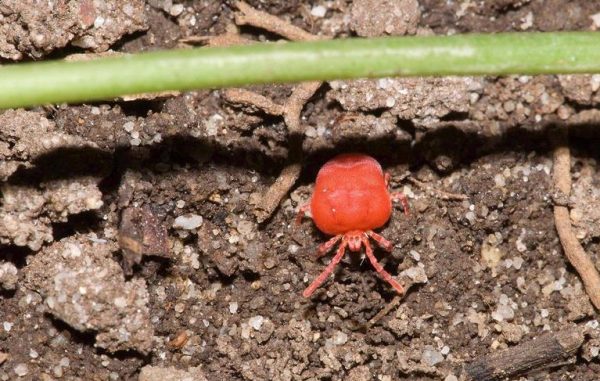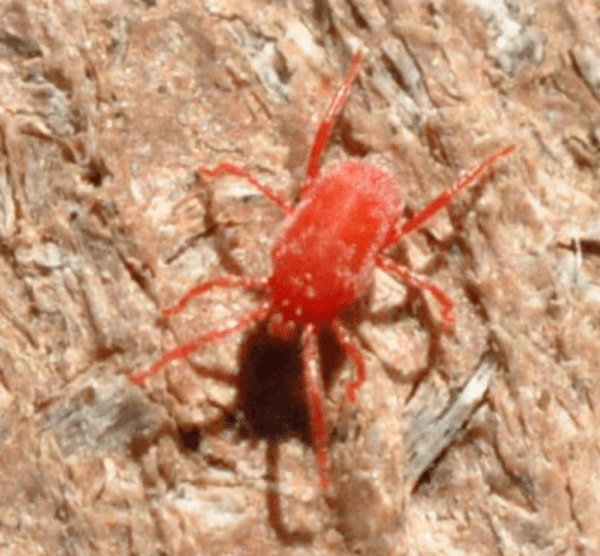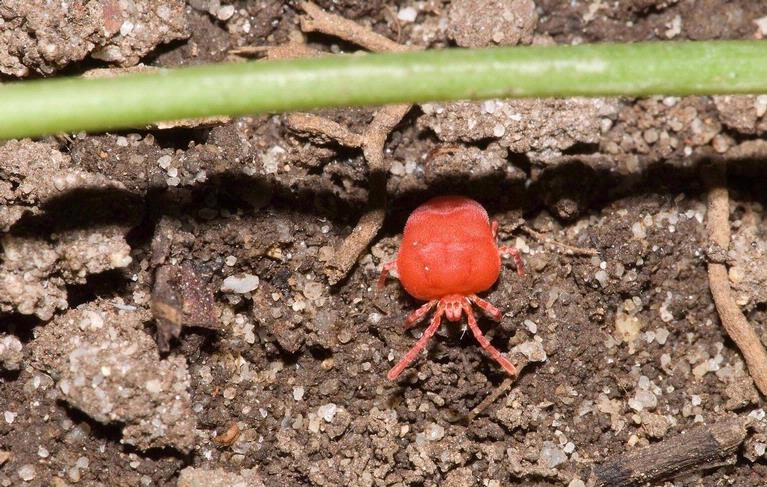Home

Chigger mites in their larval stage are serious parasitic pests of humans and animals. In their nymphal and adult stages, they are a harmless nuisance but are beneficial because they prey on small arthropods. While concrete mites are a nuisance, they are not a health concern.
Among the hundreds of outdoor pests you may see crawling around, two types of red-colored mites are common in Alabama: chigger and concrete mites. Though similar in appearance, they have distinguishing characteristics and behaviors that set them apart.
Chigger Mite

Figure 1. Chigger mites are born bright red but fade to yellow when well fed (Photo credit: Susan Ellis, bugwood.org).
Chiggers, also called redbugs, are often confused with jiggers, which are a type of flea. There are many chigger mite species in Alabama, but only a few bite humans. Chiggers are specifically known for their parasitic larvae in the Trombiculid family. The most common chigger species is the hard-biting Trombicular alfreddugesi (figure 1).
Identification
Chigger mites are born bright red but fade to yellow when well fed. Though barely visible to the naked eye, they can be spotted when gathered in groups or are on a light-colored background.
At the larval stage, the body of a chigger measures less than 0.4 millimeter in diameter and has three pairs of legs. At the nymphal and adult stages, they have four pairs of legs, with the adult bigger in size by about 1 millimeter in diameter.
Life Cycle
Chigger mites go through a life cycle of four stages: egg, larva, nymph, and adult. Adults overwinter in soil or ground litter. In the spring, adults lay eggs in moist soil, leaf litter, or other protected places. Eggs hatch into six-legged larvae we call chiggers.
Larvae climb onto vegetation; from there they readily grab onto a passing host, which can be a person or animal. Larvae feed on only one host in their lifetime. After feeding, they fall off the victim to the ground and molt into nymphs, which then mature into the eight- legged adults. The normal life cycle is 2 to 12 months depending on the species and environmental conditions.
Habitats and Food Sources
Chigger mites live outdoors and prefer undergrowth vegetation in shaded areas with higher humidity. Unlike many mites that have the same diet from birth to death, chiggers not only vary in look but also in behavior and diet at different life stages.
In their larval stage, the six-legged larvae are parasitic; they dine on vertebrate animals such as humans, reptiles, birds, rodents, some amphibians, and other wild and domestic mammals. After developing into eight- legged nymphs and adults, they become free-living predators; they eat small arthropods and insect eggs or plant material in the soil but not vertebrate animals.
Pest Status
Chiggers feed only in the larval stage on humans and other animals. Nymphs and adults are harmless to humans and animals. After snagging a host, the larva chigger moves fast to locate skin where it can grab its once-in-a-lifetime meal, which may take several days, much like ticks. Chiggers prefer tender skin or areas where the skin wrinkles and folds.
Chiggers feed from the skin surface. They are not capable of burrowing under skin like scabies mites. They also do not drink blood like mosquitoes and bedbugs. Chiggers have a piercing mouth that is short and can penetrate only a thin layer of skin. After piercing the skin, the chigger injects saliva into its victim. The saliva contains digestive enzymes that can liquefy the skin cells for the chigger to use as food.
The piercing and eating process results in a similar sensation to being bitten. The digestive saliva injected induces reddish welts on the skin and causes intense inching that can last for several days to 2 weeks. A chigger often goes unnoticed for 1 to 3 hours after it starts feeding. Itching usually occurs after the larva has detached from the skin. American chiggers are not vectors of any disease.
Protecting Yourself from Chigger Infestation
Larval chiggers occur from spring into summer and are most active in the afternoon and when the ground temperature is between 77 and 86 degrees F. They become inactive when the surface temperature falls below 60 degrees F or rises above 99 degrees F. If you are outside, avoid known chigger-infested areas.
If you must enter dense undergrowth areas, use EPA- approved repellent products to avoid chigger attacks. Apply the repellent to clothing around the ankles, waist, and arms. Also dress for protection—loose, long sleeves and pants, tightly woven socks and clothes, pants tucked into high shoes or boots. After completing outdoor activities, change clothes as soon as possible and wash them in hot, soapy water.
Controlling Chiggers Outdoors
Clearing out breeding sites is the best solution to controlling chiggers. The best time to do this is in the spring before chigger populations grow big. Cut down shrubs, remove brush, mow grass short, and prune trees to open up the area to sunlight, raise soil temperatures, and lower humidity. These cultural practices create habitats less suitable for chiggers and their animal hosts.
Some insecticides are registered for chigger control. However, insecticide spray alone cannot be a long-term solution due to their limited efficacy and residue period. If you must apply insecticide, direct the spray toward borders and fences between woody areas and the lawn, around ornamental plantings, beside foot paths, and in areas where chiggers and their animal hosts are known to be abundant. A single application in May is often all that is required. In severe infestations, retreatment is needed after 2 to 3 weeks. Do not treat areas where livestock feed or graze. Keep children and pets off treated areas until dry. Follow label instructions when applying these products.
Do not use household products such as kerosene, turpentine, ammonia, alcohol, gasoline, or dry-cleaning fluid for chigger control. These are not effective.
Concrete Mites
Concrete mites, also called sidewalk mites, are another tiny, bright-red mite commonly seen in Alabama. They are a complex of various species belonging to the genus Balaustium in the Erythraeidae mite family. They are called concrete mites because of the locations where they tend to aggregate. They are often seen in large numbers scurrying around on concrete pavements, patios, masonry foundations, outside walls of homes and buildings, stonework, and other outdoor objects such as trash bins and picnic tables for a brief period.
Identification

Figure 2. Concrete mites are elongated in shape. They have one or two pairs of eyes set well back on the body and a distinct gap between the second and third legs. (Photo credit: Lee Townsend, UK)
Concrete mites are elongated in shape. They have one or two pairs of eyes set well back on the body and a distinct gap between the second and third legs (figure 2). Adults are 1 to 2 millimeters in length, larger than chigger mite adults.
Concrete mites are often mistaken for clover mites (Bryobia praetiosa) or chiggers. Clover mites, however, are reddish brown in color, and the two front legs are about two times the length of the other legs. Additionally, clover mites are found on clover or surrounding plants whereas concrete mites are often seen on the surface of concrete and masonry.
Biology
Concrete mites are commonly found in urban areas. They breed outdoors in moist, organic, vegetative environments. Generally found from spring to fall, with peak numbers in spring and early summer, they produce at least two generations per year. Fast moving and sunshine loving, they are most active on nice sunny days.
Like chigger mites, concrete mites have a life cycle of four stages: egg, larva, nymph, and adult. Unlike chigger mites, concrete mites have lost the parasitic association as larvae. Instead, all their active stages (larva, nymph, adult) are predators with piercing mouths. They eat other soft-bodied arthropods, including mites and small insects or insect eggs. They also are capable of supplementing their meat diet with pollen, especially in their larval stage. This explains why the mites can be found on nearly any outdoor surface and in flowers, because pollen is everywhere and they are in search of food.
Pest Status
Concrete mites are actually beneficial mites. They do not cause damage to household products or homes. It is not clear if they bite people or pets. They can be a nuisance pest when a large number of them invade homes or congregate on surfaces where people may sit. When squashed or sat upon, they leave red stains. The stain is not blood; it is just their natural color.
Control of these beneficial mites is not usually needed because their mass gatherings are short-lived. Should these mites threaten to spoil an outdoor event, such as a spring wedding that involves white clothing, or invade the interior of your home, they can be controlled with a surface spray of a pyrethroid insecticide.
 Xing Ping Hu, Extension Specialist, Professor, Entomology and Plant Pathology, Auburn University
Xing Ping Hu, Extension Specialist, Professor, Entomology and Plant Pathology, Auburn University
New August 2021, Chigger & Concrete Mites, ANR-2801

